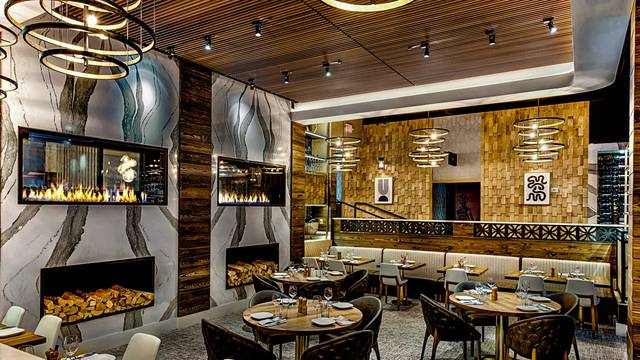Instagrammable Restaurants Islamabad: Picture-Perfect Dining Knowledge
Instagrammable Restaurants Islamabad: Picture-Perfect Dining Knowledge
Blog Article
Savor Authentic Oriental Food With a Pan-Asian Spin for a Cooking Experience
Getting started on a culinary trip via genuine Oriental food, improved with a Pan-Asian spin, provides an one-of-a-kind chance to check out the rich tapestry of tastes that define the area's diverse cooking traditions. As you ponder these tempting dishes, consider the cultural narratives and historical influences that form them, each bite offering a tale waiting to be uncovered. asian fusion restaurant.

Discovering Pan-Asian Tastes
In the realm of international gastronomy, Pan-Asian cuisine stands out for its remarkable variety and the harmonious interaction of flavors from different Asian societies. This culinary technique celebrates the abundant customs and distinct active ingredients located across the continent, creating a tapestry of preferences that is both fascinating and satisfying. Secret to Pan-Asian food is its capability to stabilize contrasting tastes-- wonderful, salty, spicy, and sour-- while highlighting the quality and high quality of each active ingredient.
From the umami-rich soy sauce of Japan to the intense chili peppers of Thailand, Pan-Asian food provides an extensive scheme of tastes. These elements are typically combined in inventive means, enhancing dishes with layers of complexity. As an example, using fragrant herbs such as lemongrass and cilantro, usual in Vietnamese and Thai cuisine, includes a revitalizing brightness to dishes, while the consolidation of coconut milk provides a luscious, abundant texture.
The focus on fresh fruit and vegetables and fragrant flavors makes certain that each dish is not only a banquet for the preference buds yet additionally for the detects. Pan-Asian food invites restaurants to start a culinary journey, checking out the huge and varied landscapes of Oriental gastronomy with every bite.
Blend Recipes to Attempt
While Pan-Asian food is commemorated for its traditional flavors, the modern culinary landscape is increasingly accepting combination dishes that blend these traditional aspects with influences from various other areas. This innovative method not just honors the abundant heritage of Eastern culinary arts but also introduces unique preference experiences that attract modern tastes buds.
An archetype of such a combination recipe is the Korean-Mexican taco, where marinated bulgogi beef is wrapped in a warm tortilla, topped with kimchi and a spicy gochujang-infused salsa. This combination weds the bold, mouthwatering tastes of Korea with the vivid, fresh components of Mexican food. Similarly, sushi burritos have gotten popularity, integrating the fragile creativity of Japanese sushi with the hearty, hand-held ease of a burrito, typically including combination active ingredients like tempura shrimp and avocado with a drizzle of wasabi mayo.
Another noteworthy dish is Thai curry ramen, which instills the luscious, fragrant seasonings of Thai curry into the comforting broth of standard Japanese ramen, creating an unified mix that entices the detects. These fusion recipes expand past simple novelty; they represent a cooking dialogue in between societies, urging exploration and innovation on the planet of Pan-Asian food.
Vital Ingredients and Seasonings
To really appreciate Pan-Asian cuisine, one have to understand the necessary components and seasonings that create its structure. This diverse culinary style attracts from a rich tapestry of Oriental customs, utilizing an unified blend of structures and flavors.
Aromatic components are pivotal, with garlic, ginger, and lemongrass being ubiquitous throughout different Pan-Asian dishes. These active Web Site ingredients offer a fragrant base that boosts the complexity of tastes. Seasonings such as celebrity anise, cardamom, and cinnamon introduce warmth and character, resembling impacts from regions like China and India.

Food Preparation Strategies and Tips
Grasping the art of Pan-Asian food needs familiarity with its unique food preparation methods, each contributing to the vivid tapestry of flavors this culinary custom is celebrated for. Central to these techniques is the stir-fry, a fast food preparation method that protects the nutritional integrity and vibrant shades of components. Making use of a wok, the stir-fry approach enables also warm circulation, crucial for accomplishing the characteristic texture and taste equilibrium of Pan-Asian meals.
An additional essential method is steaming, especially common in Chinese cuisine. This mild technique keeps the all-natural flavors and nutrients of active ingredients, making it excellent for fish and shellfish and vegetables. Dumplings, a cherished staple, often gain from steaming, resulting in soft, succulent textures.
Grilling, also essential, gives smoky midsts to dishes such as Oriental bulgogi or Japanese yakitori (pan asian restaurant Islamabad). This method typically involves seasoning ingredients, permitting flavors to pass through deeply prior to food preparation over an open flame or warmer
Last but not least, understanding the art of balancing flavors-- sweet, sour, salty, bitter, and umami-- is important. Correctly layering these elements can raise a meal from average to phenomenal, providing a complex and pleasing cooking experience that embodies the essence of Pan-Asian food.
Dining Experiences Worldwide
Throughout the globe, Pan-Asian food supplies an unparalleled dining experience, commemorated for its rich tapestry of tastes and vibrant discussions. This cooking phenomenon has gone beyond social limits, capturing the hearts and palates of food enthusiasts worldwide. In cosmopolitan cities fresh York, London, and Sydney, Pan-Asian restaurants function as melting pots where culinary traditions from Thailand, Japan, China, and past converge, providing diners with a diverse mix of recipes that highlight the region's diversity.
The worldwide appeal of Pan-Asian food depends on its capability to provide both authenticity and innovation. Chefs masterfully marry traditional components such as lemongrass, soy sauce, and miso with contemporary techniques, causing meals that are both refreshingly new and familiar. This blend allows restaurants to start a cooking journey that respects heritage while welcoming modernity.
Moreover, eating experiences are raised via thoughtfully created atmospheres that reflect the principles of Pan-Asian looks. From minimal Japanese-inspired interiors to vibrant Thai-themed spaces, each restaurant provides a special setting that enhances the cooking offerings. Therefore, customers are not simply consuming a meal yet partaking in a cultural experience, making Pan-Asian eating a really international phenomenon.
Conclusion
The exploration of Pan-Asian cuisine supplies a read here profound understanding of the complex interplay of flavors and culinary traditions throughout Asia. By accepting combination dishes such as Thai curry ramen and sushi burritos, the cooking journey not just highlights the versatility of traditional active ingredients however also showcases ingenious modern-day strategies. This gastronomic adventure, enriched by necessary seasonings and cooking techniques, offers a special opportunity to value the social variety and cooking artistry that specify Pan-Asian food on a worldwide scale.
Getting started on a cooking trip with authentic Eastern cuisine, enhanced with a Pan-Asian spin, supplies a special possibility to check out the abundant tapestry of flavors that define the region's varied culinary traditions.In the world of worldwide gastronomy, Pan-Asian cuisine stands out for its amazing diversity and the harmonious interplay of tastes he has a good point from different Oriental societies. Key to Pan-Asian food is its capability to stabilize different flavors-- sweet, salty, spicy, and sour-- while highlighting the freshness and high quality of each component.

Report this page